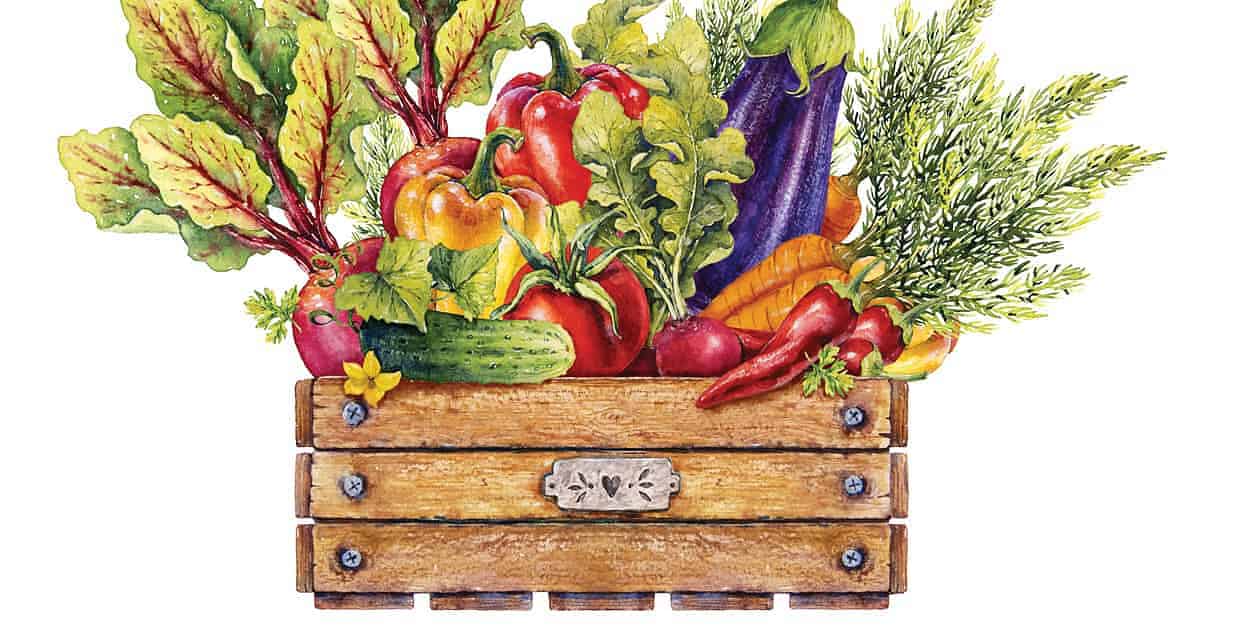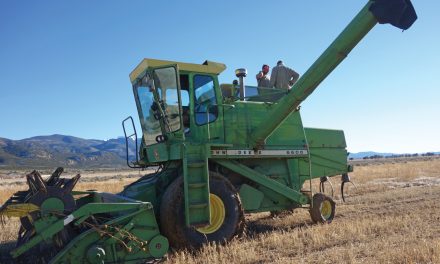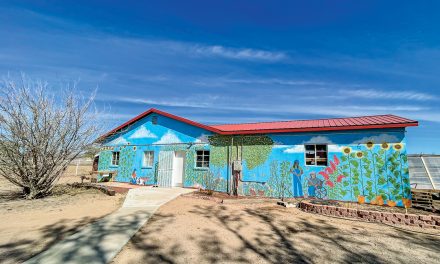Local food committed to feeding community in the face of COVID-19
By Sarah Wentzel-Fisher

In a long but short three months, we’ve seen many local businesses getting extremely creative in providing food to their communities and actively expanding and shaping our local food systems. With a shared ethos of getting as much food as possible to their neighbors safely, local growers and food distributors have risen to the challenges of shifting national supply chains, markets, consumer buying habits, and health safety protocols within the failure and fracturing of a fragile food system.
In the United States, JBS, Tyson, and Smithfield control over 60 percent of all meat production, and approximately the same percentage of produce consumed in the country comes from the ninety-mile stretch that is the Salinas Valley in California. To say our food systems are monopolized, consolidated, and, as a result, vulnerable to failure, is an understatement. During the pandemic, federal leadership has not mandated that large agribusinesses make their working environments safe for essential workers to produce the food we all eat, a reality that has compromised our economy and security in deep and fundamental ways. Meanwhile, local farmers and ranchers have hustled to adjust their businesses to ensure that as much safe food reaches as many people in their communities as possible.
As of March 1, 2020, the United States was reporting only eighty-eight cases of COVID-19. By March 15, four cases of the virus had been reported in New Mexico, and toilet paper shortages began to make the front page. On March 23, Governor Michelle Lujan-
Grisham, along with many other governors across the country,
declared that nonessential businesses would need to close their doors for at least two weeks, possibly longer. By April 7, meatpacking plants had turned into hot spots, and rather than strategize to make their work environments safe, corporations closed plants. At this point, it was clear the virus was here to stay. Our lives, and the food systems we rely on, were in the throes of major change.
For those running farm and local food distribution businesses, these events came at a moment when the seasonal ball was already rolling. Fields had been planned; seeds had been ordered or started and were nearing their planting dates; restaurants and schools had been contracted for sales later in the season. For those raising livestock, early season dates at the processing plant had been scheduled, and cows and sows were giving birth to calves and piglets. Farming, in the best of times, is high risk, in part because it requires months and sometimes years of upfront investment with little certainty of what unpredictable weather or markets will bring. For local growers who rely on stalwart restaurant buyers and the intimacy of a packed farmers market stand to earn their living, closure of nonessential businesses, stay-at-home orders, and growing fears about the consequences of being in public places came as a bucket of cold water in the face. For those running farms, local food distribution businesses, CSAs, or small grocery businesses, this also meant pivot or perish.
In Albuquerque, the Rio Grande Farmers Coalition met March 9 for their monthly meeting. The priority topic was how they collectively were going to respond to and support each other in adapting to the nascent pandemic. While the cases of coronavirus in the US were still under a few hundred people, the direction of the disease was clear. Diversified farmers in Albuquerque like Casey Holland of Chispas Farm, Ian Colburn of solarpunk and Ironwood farms, and Seth Matlick of Vida Verde Farm rely on two primary markets—sales to restaurants and farmers markets. Each has offered a very small CSA depending on the year, but this has not been a primary mode of selling and distributing the food they grow.
With rumors of delay or cancellation of the Downtown Growers Market, a group of farmers proposed working together to create an aggregated CSA so that consumers could get fresh produce without the risks involved in going to the grocery store, and so that the farmers would have a market for early season crops. This led to discussions about how to aggregate food, how to make ordering straightforward for customers, and how to ensure minimal handling of food. The pandemic forced conversations about deeper collaboration and information sharing that this group had often broached, but had never really carved out time to explore. Within a week, they had sold out forty-five shares and had a waiting list of customers for a six-week CSA. They are now in their third round of offerings, and continue to improve and refine the process of getting food directly to eaters safely. In addition to this cooperative effort, these farms have also developed single-farm CSAs, are selling at downtown Albuquerque’s drive-thru farmers market, and continue to test new ways of getting food to consumers.
For Nina Yozell-Epstein, owner and operator of Squash Blossom Local Food, the backbone of her business prior to the pandemic had been wholesale to restaurants in Santa Fe. As a supplement to these sales, she offered Blossom Bags, a service for individuals to get weekly bags of seasonal produce from a variety of farmers from northern New Mexico. She averaged twenty-five bags a week in the winter and around fifty per week in the summer. When restaurants were required to close, the majority of her business disappeared overnight. Within the same week, orders for her Blossom Bags went from twenty-five to more than two-hundred fifty.
On the surface, this seems like an all’s-well-that-ends-well kind of story, but making this kind of shift in just a few days requires imaginative thinking, sleepless nights, and the fortitude to remain kind and engaged with customers even when you’re dog-tired and grumpy. Fortunately, Yozell-Epstein had tuned in to global news of the pandemic, and made a decision at the beginning of the year to order a large number of small coolers before mandated closures, meaning she was partly prepared to change her business on short notice.
Restaurants order produce in large quantities and with a certain consistency. It’s a very different process than filling two-hundred fifty bags with household quantities of fresh veggies and options for more than forty add-ons—the labor, time, and space required to deliver the same volume of food increases significantly. Yozell-Epstein was able to hire new staff to help with order fulfillment and find extra space to rent in the warehouses where she runs her business. Her landlord knew that rents might be short due to the closures and that nonessential businesses might be unable to weather the changes, so they happily rented her additional space to expand the Blossom Bags part of Squash Blossom.

Yozell-Epstein fears how hard it will be for her restaurant partners to bounce back. “Small, independent, locally owned businesses are what make Santa Fe special, and right now, we risk losing it.” In addition to being able to serve a larger number of households, Yozell-Epstein also became creative to help her restaurant customers. For those preparing to-go meals, she encouraged her retail customers to patronize them by working with them as pick-up points for the Blossom Bags. At the five sites she worked with, many were able to add shifts for employees on the days when customers picked up their bags.
Even if a local food distribution business is designed to serve individual customers, this sort of shift presents challenges. At the beginning of March, Beneficial Farms CSA officially changed ownership and names to New Mexico Harvest (NMH). Owner/operator Thomas Swendson set a goal of enlisting three hundred members in the first year of operation under the new name. Within three weeks of launching, he hit his goal and had a wait-list. Swendson started his career in trucking logistics, and spent many years coordinating MoGro, a nonprofit mobile grocery project bringing healthy and local food to rural communities in central New Mexico. In spite of his years of experience, the sudden demand for NMH services has created a steep learning curve.
In addition to reaching capacity in terms of the number of households the CSA could serve, consumer purchasing patterns also dramatically changed with the pandemic. Rather than using the CSA as a supplement to grocery store purchases, a large number of customers made NMH their primary food shopping for the week, increasing the average purchase amount by three or four times. This allowed Swendson to absorb much of what growers he worked with had planned before the shutdowns to sell to schools and restaurants in the spring.
Swendson has also been in regular contact with other aggregator CSAs, like Squash Blossom in Santa Fe and Agri-Cultura Network in Albuquerque, to share where there’s abundance and to ask for help when NMH runs short on certain items. He sees value in building the collective infrastructure and shared knowledge to enable local food systems to serve more people in New Mexico, not just in times of crisis, but always.
Ethan and Zach Withers, owners and operators of Polk’s Folly Farm, a small hog operation in the East Mountains, opened a small farmstand with a commercial kitchen last November. The goal was twofold: to have a place to process their own meat and to offer a sales venue to other East Mountain growers after the market season closed. For the first three months, they opened once a week for a few hours and served several dozen customers. In early March, they remodeled the retail space, enabling them to put a few more items on the shelves, including flour from Valencia Mills and milk from De Smet Dairy, to round out the meat, veggies, and honey they’d been selling. The new space brought additional customers and a pleasant 20 percent increase in sales, so they decided to open two days a week.
When news of the pandemic was followed by reports on hoarding, they anticipated that purchases might increase and stocked up on additional items in anticipation. On March 27, a line of people queued across the parking lot from a few minutes before they opened until almost the close of business. Like other local food purveyors, they saw their sales quadruple in a single weekend. While the bump in revenue was welcome, their freezers had been cleaned out. The brothers immediately began to hustle to find additional local meat and other goods to stock for the following week.
Zach Withers first met Dr. Manny Encinias at a Meat-to-Market workshop hosted by the Southwest Grassfed Livestock Alliance, where producers learned that how an animal is broken down translates into direct sales to consumers. Encinias is a fifth-generation rancher from just south of Moriarty who launched Trilogy Beef Community late in 2019. For the last eighteen years, Encinias has also worked in consulting and management for family-owned ranching operations in New Mexico and has evaluated many coordinated beef supply chains across the US. In 2017, he moved back to the family ranch in New Mexico after spending time managing a ranch in Hawaii. His time on the islands taught him to deeply appreciate and value local food, good relationships with neighbors, and healthy working lands.
Trilogy Beef Community is as much a demonstration project as it is a beef business. The business began by selling the beef of three ranchers, including Encinias, but it now includes more beef from other similarly managed family-owned ranches. Their mission is twofold—to deliver high quality New Mexico–raised beef to New Mexicans, and to show other ranchers in the state that finishing and selling beef in the state is a viable business model. When they launched, the concept was to work with restaurants around the state to build their brand and a solid local market. When the pandemic hit, they shifted to selling directly to consumers through an online platform for direct meat sales and servicing the needs of some Native American communities.
The week of March 27, with national headlines focused on meatpacking plant closures and Polk’s Folly’s freezers empty, Withers spent nearly eighteen hours a day making and responding to phone calls and texts from other farmers and food distributors. First, he called Encinias. Now, Polk’s Folly stocks both grass- and grain-finished New Mexico–raised beef at prices that outcompete conventional beef prices at the grocery store.
That week Withers also called Emily Cornell, a young rancher developing a grassfed beef business running a herd on Sol Ranch, her family’s ranch near Wagon Mound. He arranged to have Cornell bring four of her animals to a processor in Colorado the next week, knowing that they didn’t have nearly enough freezer space for that much meat (a whole steer will yield approximately four hundred pounds of beef), but also knowing that meatpacking plant closures and consumer buying behaviors meant there would be more than adequate demand if he could sort out the details and work with other local food purveyors to get the meat to local consumers.
He also immediately called Holland, Matlick, and Swendson, alerting them that he would have extra beef. Swendson added the grassfed beef to the list of items his customers could choose for their bags, and Withers agreed to send Swendson a list every week of the extra items he needed to sell to accommodate his cold storage. The Polk’s Folly farmstand also became a pick-up point for NMH customers, increasing the reciprocity in the relationship. Withers now delivers meat and flour weekly to all of these CSAs to offer a complete grocery bag to their customers, and the conversations continue on how they can share transportation, cold storage, information, and food.

For Polk’s Folly, the biggest challenge has always been a lack of readily available USDA-inspected slaughter and processing capabilities. New Mexico has one medium-sized packing plant in Roswell slaughtering and processing for US Foods, and two other small facilities with limits on the types and number of animals they’re able to handle. The Withers had been bringing their hogs to Salazar Meats just across the border in Colorado, but in early May, the owner let them know that his facility had been completely booked out for the rest of the year and they would need to look for other options.
Ranchers in the area who usually sell their live animals into conventional meat markets feared the implications of meatpacking plant closures. In anticipation of facing a decision between continuing to feed their animals without a potential market or having to euthanize, ranchers took quick steps to adapt to changing markets and were booking slots for their animals at smaller processing plants. The repercussion for Polk’s Folly was being squeezed out of already limited options for slaughter and processing.
In nearby Mountainair, Nancy McCloud has always carried a handful of local produce items (many she grows herself), but local food hasn’t been the main focus of her store—feeding her community has. McCloud decided to tackle mitigating the food desertification of her community in 2016, after the only grocery store in town closed and the nearest grocery option was a ninety-seven-mile trip. Not even four years later, she’s still going strong, but is experiencing the challenges of the pandemic as much as any other small food business in the state.
Like others, McCloud saw increased customer demand and a shift in the types of food people would buy. After discouraging an initial surge of hoarding, she noticed that rather than buying frozen and prepared foods, people were buying raw ingredients to prepare food at home: flour, fresh vegetables, and meat. She said she hasn’t been able to keep yeast on the shelves. She can no longer order pre-packaged yeast and has taken to ordering it in bulk and bagging it into smaller portions. McCloud, who is completing a master’s degree in nutrition and is an avid gardener, introduces new ideas for home cooked meals to her customers through Friday evening pick-up dinners that she prepares for the community, offering adventurous meals and recipes.
In mid-April, McCloud started to notice a shift both in prices and availability from her wholesale distributors. She reported at the beginning of June that it had been a month of not knowing what items on her orders she would actually receive with often nearly a third missing. In addition, the prices on staples, especially meat like ground beef, have crept higher every week since the pandemic hit.
Mountainair is surrounded by many ranches. McCloud was hearing from her neighbors who sold their animals at auction that cattle prices were the lowest they’d seen in decades. The math didn’t add up. As a woman deeply committed to her community, she decided to take action that would solve her meat price issues and her neighbors’ cattle price woes.
Mountainair is also home to a small USDA inspected meat processing plant—the type of plant required for packaged meat to be resold through retail outlets like grocery stores. The plant closed in May 2019, largely due to failure to meet inspection requirements designed for large corporate plants—not an uncommon story for small plants. In early April 2020, motivated by neighboring ranchers and a desire to keep her prices affordable for her customers, she partnered with the plant operator to bring it back online. Almost exactly a year after the plant’s closing, the team effort has the plant processing New Mexico meat for New Mexico eaters. McCloud can now purchase animals from her neighbors and continue to offer quality ground beef at prices she’s comfortable charging.
Local farmers and food distributors have not only risen to the challenges presented by food system failures during the pandemic, they have leaned into the opportunity and are creating new systems, working together to move food around the state. Some of the challenges and opportunities they face moving forward are twofold: first, how will consumer behaviors shift again as states reopen; second, if demand continues to increase, what will be the best ways to increase the supply of local food. While these producers and distributors have risen to the challenges the pandemic presents, if they were tasked with feeding all New Mexicans, the volume of food would fall woefully short of what’s actually needed. The expansive gap between large aggregated supply chains and local food systems is still too large to ensure true food security in the state, but these champions of local food are ensuring we have readily available, safe, and healthy food.
What can consumers do to help? Learn to love to eat seasonally and to eat foods that love to grow here. Commit to supporting these businesses not just when they’re the most convenient option but for the long haul. Plant a garden. Let a farmer plant your land if you have it. Meet your farmers and food distributors and get to know their businesses. If possible, don’t choose the cheap and easy food option—choose the option you know supports local because they will be the ones who step in to support you when you need them most.
According to data collected by the Food and Environment Reporting Network, “As of June 5 [2020], at least 276 meatpacking and food processing plants and 38 farms and production facilities have confirmed cases of COVID-19, and one food processing plant is currently closed. At least 25,221 workers (21,362 meatpacking workers, 1,641 food processing workers, and 2,218 farmworkers) have tested positive for COVID-19 and at least 95 workers (86 meatpacking workers, 7 food processing workers, and 2 farmworkers) have died.” According to industry statistics, the meatpacking industry employs five hundred thousand people, meaning one in twenty-three people who work in a plant has been infected, or some of the highest per capita infection rates in the country. This does not account for individuals working in big box grocery stores like Walmart, which has also seen closures recently with a large number of employees getting sick.
Edible celebrates New Mexico's food culture, season by season. We believe that knowing where our food comes from is a powerful thing. With our high-quality, aesthetically pleasing and informative publication, we inspire readers to support and celebrate the growers, producers, chefs, beverage and food artisans, and other food professionals in our community.












